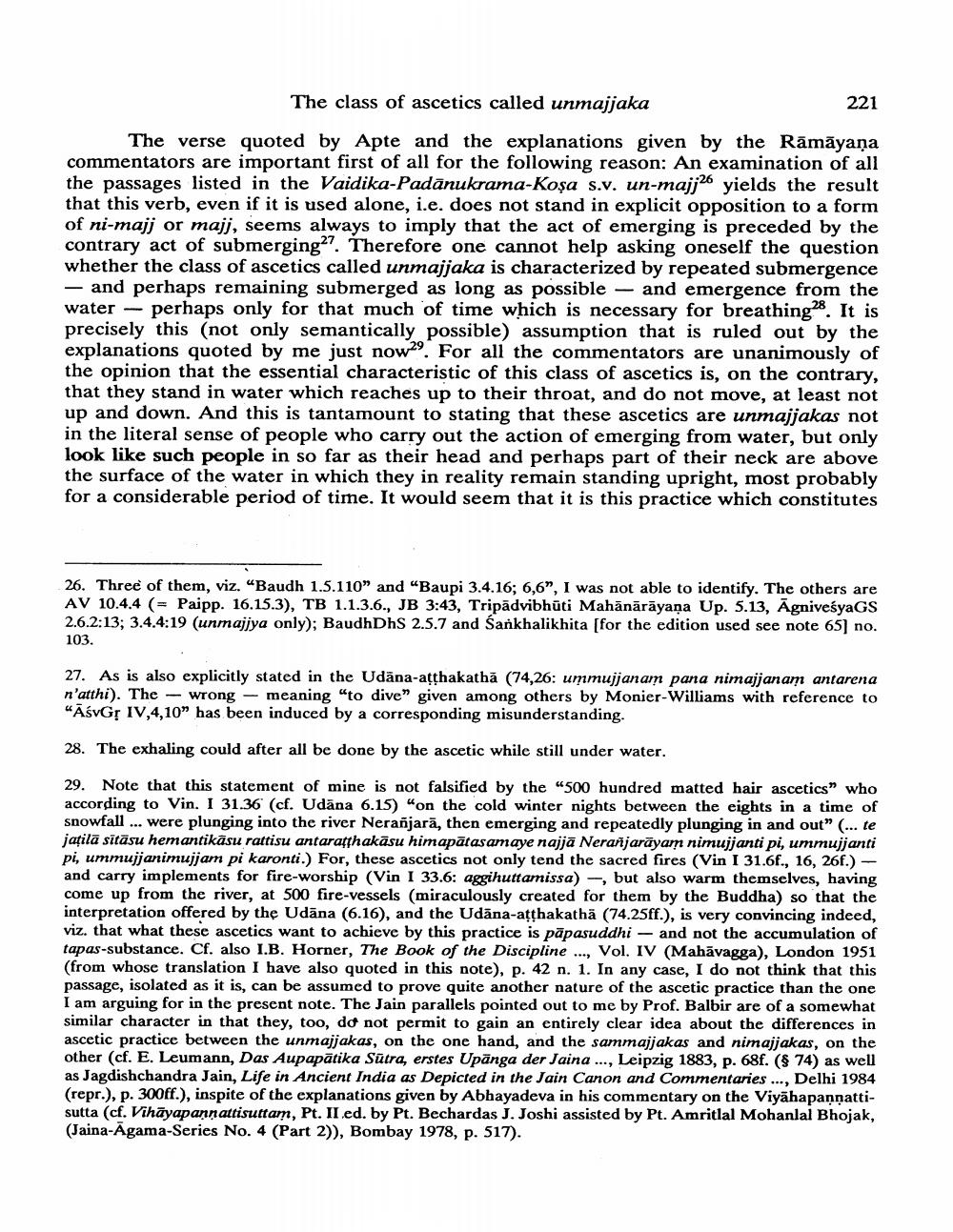Book Title: Note On Class Of Ascetics Called Unmajjaka Author(s): A Wezler Publisher: A Wezler View full book textPage 5
________________ The class of ascetics called unmajjaka 221 The verse quoted by Apte and the explanations given by the Rāmāyaṇa commentators are important first of all for the following reason: An examination of all the passages listed in the Vaidika-Padānukrama-Koşa s.v. un-majj26 yields the result that this verb, even if it is used alone, i.e. does not stand in explicit opposition to a form of ni-majj or majj, seems always to imply that the act of emerging is preceded by the contrary act of submerging?7. Therefore one cannot help asking oneself the question whether the class of ascetics called unmajjaka is characterized by repeated submergence - and perhaps remaining submerged as long as possible - and emergence from the water - perhaps only for that much of time which is necessary for breathing?8. It is precisely this (not only semantically possible) assumption that is ruled out by the explanations quoted by me just now29. For all the commentators are unanimously of the opinion that the essential characteristic of this class of ascetics is, on the contrary, that they stand in water which reaches up to their throat, and do not move, at least not up and down. And this is tantamount to stating that these ascetics are unmajjakas not in the literal sense of people who carry out the action of emerging from water, but only look like such people in so far as their head and perhaps part of their neck are above the surface of the water in which they in reality remain standing upright, most probably for a considerable period of time. It would seem that it is this practice which constitutes 26. Three of them, viz. "Baudh 1.5.110" and "Baupi 3.4.16; 6,6", I was not able to identify. The others are AV 10.4.4 (= Paipp. 16.15.3), TB 1.1.3.6., JB 3:43, Tripadvibhuti Mahänārāyana Up. 5.13, ĀgniveśyaGS 2.6.2:13; 3.4.4:19 (unmajjya only); BaudhDhS 2.5.7 and Sankhalikhita [for the edition used see note 65) no. 103. 27. As is also explicitly stated in the Udäna-atthakathā (74,26: ummujjanam pana nimajjanam antarena n'atthi). The wrong - meaning "to dive" given among others by Monier-Williams with reference to "ĀśvG? IV,4,10" has been induced by a corresponding misunderstanding. 28. The exhaling could after all be done by the ascetic while still under water. 29. Note that this statement of mine is not falsified by the “500 hundred matted hair ascetics" who according to Vin. I 31.36 (cf. Udäna 6.15) "on the cold winter nights between the eights in a time of snowfall ... were plunging into the river Neranjarā, then emerging and repeatedly plunging in and out" (... te jațilā sitāsu hemantikāsu rattisu antaratthakāsu himapātasamaye najjā Neranjarāyam nimujjanti pi, ummujjanti pi, ummujjanimujjam pi karonti) For, these ascetics not only tend the sacred fires (Vin I 31.6f., 16, 26f.) - and carry implements for fire-worship (Vin I 33.6: aggihuttamissa)-, but also warm themselves, having come up from the river, at 500 fire-vessels (miraculously created for them by the Buddha) so that the interpretation offered by the Udāna (6.16), and the Udāna-atthakathä (74.25ff.), is very convincing indeed, viz. that what these ascetics want to achieve by this practice is pāpasuddhi - and not the accumulation of tapas-substance. Cf. also I.B. Horner, The Book of the Discipline ..., Vol. IV (Mahāvagga), London 1951 (from whose translation I have also quoted in this note), p. 42 n. 1. In any case, I do not think that this passage, isolated as it is, can be assumed to prove quite another nature of the ascetic practice than the one I am arguing for in the present note. The Jain parallels pointed out to me by Prof. Balbir are of a somewhat similar character in that they, too, do not permit to gain an entirely clear idea about the differences in ascetic practice between the unmajjakas, on the one hand, and the sammajjakas and nimajjakas, on the other (cf. E. Leumann, Das Aupapātika Sütra, erstes Upānga der Jaina ..., Leipzig 1883, p. 68f. ($ 74) as well as Jagdishchandra Jain, Life in Ancient India as Depicted in the Jain Canon and Commentaries ..., Delhi 1984 (repr.), p. 300ff.), inspite of the explanations given by Abhayadeva in his commentary on the Viyahapannattisutta (cf. Vihāyapannattisuttam, Pt. II ed. by Pt. Bechardas J. Joshi assisted by Pt. Amritlal Mohanlal Bhojak, (Jaina-Agama-Series No. 4 (Part 2)), Bombay 1978, p. 517).Page Navigation
1 ... 3 4 5 6 7 8 9 10 11 12 13 14 15 16 17 18 19 20 21 22 23 24 25 26 27
